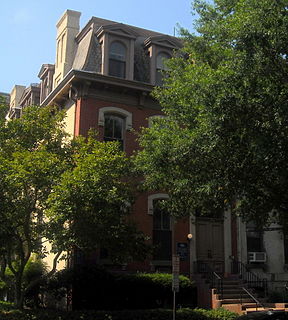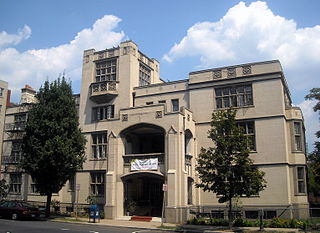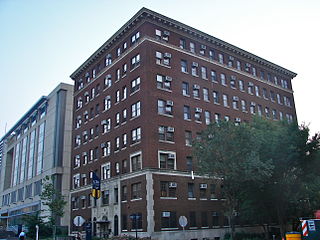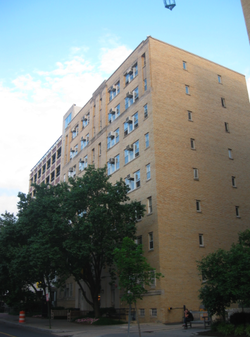
The Northeast Entrance Station to Yellowstone National Park, in Park County, Montana, is a rustic log building designed by the National Park Service Branch of Plans and Design under the direction of Thomas Chalmers Vint and built in 1935. The entrance station straddles U.S. Route 212 (US 212) west of Cooke City-Silver Gate. A combined ranger station and residence is located nearby. All buildings were constructed by George Larkin of Gardiner, Montana.

Crater Lake Superintendent's Residence, is "an impressive structure of massive boulders and heavy-handed woodwork" at Crater Lake National Park in southern Oregon. It was declared a National Historic Landmark in 1987 as an important example of 1930s National Park Service Rustic architecture.

Munson Valley Historic District is the headquarters and main support area for Crater Lake National Park in southern Oregon. The National Park Service chose Munson Valley for the park headquarters because of its central location within the park. Because of the unique rustic architecture of the Munson Valley buildings and the surrounding park landscape, the area was listed as a historic district on the National Register of Historic Places (NRHP) in 1988. The district has eighteen contributing buildings, including the Crater Lake Superintendent's Residence which is a U.S. National Historic Landmark and separately listed on the NRHP. The district's NRHP listing was decreased in area in 1997.

The Oscar W. Underwood House is a historic house located at 2000 G Street in the Foggy Bottom neighborhood Northwest, Washington, D.C.. It is nationally significant both for its association with Alabama politician Oscar Underwood (1862-1929) who lived here 1914-25, and also as the first long-term home of the Washington College of Law, the nation's first law school founded and run by women. It was declared a National Historic Landmark in 1976. The building presently houses a legal aid clinic operated by George Washington University.

This is a list of the National Register of Historic Places listings in Le Sueur County, Minnesota. It is intended to be a complete list of the properties and districts on the National Register of Historic Places in Le Sueur County, Minnesota, United States. The locations of National Register properties and districts for which the latitude and longitude coordinates are included below, may be seen in an online map.
The campus of the George Washington University (GW), originated on College Hill, a site bounded by 14th Street, Columbia Road, 15th Street and Florida Avenue, NW in Washington, DC. After relocating to the downtown financial district in the 1880s and then to Foggy Bottom in 1912, GW now has three campuses. Foggy Bottom is the location of the university's main campus in Washington, DC. Also in Washington's Foxhall neighborhood is the Mount Vernon Campus, formerly the Mount Vernon College for Women. Additionally, the George Washington University Virginia Campus is located in Ashburn, VA.

Aspen Hall, also known as the Edward Beeson House, was built beginning in 1771 as a stone house in the Georgian style in what would become Martinsburg, West Virginia. The first portion of the house was a 20 by 20 foot "fortified stone home", 2½ stories tall., in coursed rubble limestone built in 1745 by Edward Beeson I. It is the oldest house in Martinsburg.

The University of Arkansas Campus Historic District is a historic district that was listed on the National Register of Historic Places on September 23, 2009. The district covers the historic core of the University of Arkansas campus, including 25 buildings.

Paterson City Hall is located in Paterson, Passaic County, New Jersey, United States. The building is located on a block in Downtown Paterson bordered by Market Street on the north, Colt Street to the east, Ellison Street to the south, and Washington Street to the west.

The Old City Hall is located just north of downtown along a commercial corridor in Davenport, Iowa, United States. It was listed on the National Register of Historic Places in 1983.

The White River Mess Hall and Dormitory is the only remaining Civilian Conservation Corps camp structure remaining in Mount Rainier National Park. The wood-framed building was built in 1933, and comprises 2185 square feet, originally containing a kitchen dining room, living room, two bathrooms, a bedroom and a bunkroom, as well as a service porch. The building no longer serves as a residence and is used for storage. It is located at the White River entrance to the park, part of a complex of service buildings.

Meridian Hall is an historic house in the Columbia Heights neighborhood of Washington, D.C.. It has been listed on the District of Columbia Inventory of Historic Sites since 1990 and it was listed on the National Register of Historic Places in 1991 as the Mansion at 2401 15th Street, NW.

Madison Hall, formerly known as the Flagler Apartments, is a residence hall on the campus of George Washington University (GW) in Washington, D.C. The building was designed by Stern and Tomlinson and was built in 1926. The building is representative of the apartment buildings that were built from the 1920s to the 1940s that have been acquired by the university and converted into dormitories. GW bought the building in 1957 and replaced its manually operated elevators during its renovations. The building was named for both James Madison and Dolley Madison. It was listed on the District of Columbia Inventory of Historic Sites and the National Register of Historic Places in 2010.

Stockton Hall is a building on the campus of George Washington University in Washington, D.C.. It was listed on the District of Columbia Inventory of Historic Sites in 1987 and on the National Register of Historic Places in 1991.

Hattie M. Strong Residence Hall is a women's dormitory on the campus of George Washington University in Washington, D.C.. It was listed on the District of Columbia Inventory of Historic Sites in 1987 and on the National Register of Historic Places in 1991.

The Liberty Hall Site is where the remains of the early predecessor of Washington and Lee University are to be found. The Liberty Hall Academy was chartered as a degree-granting institution by the Virginia legislature in 1782, and was first located in a wood frame building near Lexington, Virginia. This first building burned down in 1783, as did its replacement in 1790. In 1793 a new three-story stone building was constructed, as was a steward's house; these buildings were followed in subsequent years by additional buildings. The roof of the main school building caught fire in 1802, and the ensuing blaze gutted the building's interior. It was declared unfit to restore, and the institution relocated into Lexington. The university conducted excavations of the site in the 1970s.
























